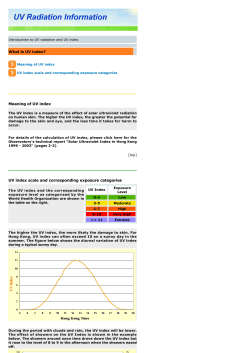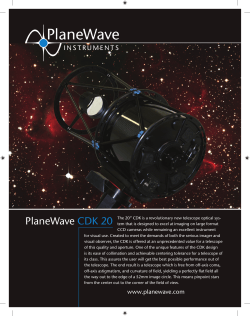
Technical Specifications Madawaska Highlands Observatory 1m f/7 Ritcher-Chrétien Nasmyth
Madawaska Highlands Observatory 1m f/7 Ritcher-Chrétien Nasmyth Technical Specifications One-Meter f/7 Ritchey-Chrétien Nasmyth Science Telescope M adawaska Highlands Observatory Corp. in addition to its flagship 1-m f/2.4 five degrees2 FOV wide-field telescope will have a second one-meter telescope of the Ritchey-Chrétien optical design (1-m RCT) with dual Nasmyth foci. This 1-m RCT is intended to supplement the wide-field telescope with a high performance camera at one focus with the other focus serving multiple applications including spectroscopy, polametry etc, this undedicated focus allows significant flexibility. Located a few tens of meters from the 1-m, f/2.4 telescope, it will benefit from the infrastructure and logistics already existing. The facility is situated in the Madawaska Highlands of Ontario with a measured nigh sky brightness of 21.9 mag/arcsec2 (40º half angle with the Unihedron Sky Quality Monitor in the v-band) the area has the darkest night skies in southern Canada and within 2 hours drive (180 Km) from Queens University. The telescope will be equipped with many of the technologies, innovations and advances used on the flagship telescope, such as carbon fibre sandwich core optical tube assembly, ultra-light vented cellular ribbed open backed mirrors, ¾ sphere Calotte dome, extensive OTA baffling, an innovative alt-az mount/drive system and advanced control electronics. The telescope will have a useful spectral range of 400-1100nm with the u’, g’, r’, i’, z’ + L+ wL filters. The observatory will be a fully autonomous instrument when used for imaging. Careful attention is being paid to achieving optimum local seeing with an advanced carbon fibre composite core Calotte dome with rapid ambient temperature tracking with filtered venting. The observatory will be energy self-sufficient operating on solar power. Figure 1 — ¾ sphere Calotte dome, pier and struts. Manufactured from the fiber this type of dome has superb airflow and other properties that make it an excellent choice for the best possible science. Madawaska Highlands Observatory — 1-m f/7 Ritcher-Chrétien Nasmyth Telescope — Technical Specifications — October 2014 T he 1 metre f/7 Ritchey-Chrétien optical system is deigned to be fully corrected across a diameter of 135 mm, with provided optics it can also be used at f/5 and f/10 giving it significant flexibility. With a Nasmyth configuration it has one undedicated focal plane where a wide variety of instruments could be used. The 2nd focus has a camera with large 95 mm CCD and employing a 10580 x 10560 array with 0.26 arcsec/pixel and 9 u pixel pitch yielding an image plane of 0.78º X 0.78º (47’ x 47’) with a total field of view of 0.6 degrees². The camera specifications are superb, cry-cooled to -100ºC with 1e-/pix/hr of dark noise, <12 e ־of read noise with readout time under 2 seconds, 16 bit sampling, 80,000e ־full well capacity and 94% quantum efficiency @ 550nm and 50% QE @ 1000 nm . The ~200 kg Optical Tube Assembly (OTA) will be built with an advanced carbon fibre sandwich core yielding a light, ultra stiff structure. It will be dimensionally stable thanks to its low temperature expansion coefficient. The forced air vented 60 kg ultra-light f/2.5 primary mirror will be made of Borofloat® with an open back cellular rib structure and thin optical surface (~0.25”), thus enabling extremely rapid tracking of ambient temperature which will eliminate mirror seeing issues. The OTA will have an electric focus on M2 with 1 u steps, extensive baffling will be used to minimize stray light and enhance contrast and flap doors will be used on the mirror to prevent dust accumulation. The low mass OTA will feature an AltitudeAzimuth mount with 10º/sec slewing, the high performance control electronics and high torque motors can point to within 5 arcsec rms (Zθ+70º) and track better than 0.1 arcsec, the periodic error will be ~2 arcsec peak-to-peak with a 20 minutes period. In addition the mount is fully programmable. It will be an autonomous observatory; all observations are scripted in advance, this will permit maximum use of the sky conditions. Figure 2— 95 mm x 95 mm CCD Imaging chip — worlds’ largest. Figure 3 — Panoramic View With Light Bubbles On Horizon. Madawaska Highlands Observatory — 1-m f/7 Ritcher-Chrétien Nasmyth Telescope — Technical Specifications — October 2014 Specifications SITE • • • • 450 metres altitude on a peak. 100 Mbps communications link to outside world for immediate data access 100 minutes from Ottawa, 2 hours from Kingston (Queens University.) 3.5 hours from Toronto/Montréal Ground 12” top-soil with granite base with ~40 acres of available relatively flat land SKY • • • ~21.90 mag/arcsec² (v). Limiting magnitude >7.1 Expected seeing 1.25 arcsec FWHM mean Excellent horizons (<2º), -45 degrees declination southern horizon available Foci 1 - 10K x 10K CAMERA • • • • • • • • • 10580 x 10560 ~ 112 mega-pixel prime focus camera (STC STA-1600A) 95.22 mm x 95.22 mm active area with 100% fill factor 0.26 arc-sec pixels (9μ pixel width) FOV 0.78º X 0.78º - 47’ x 47’ - 0.60 degrees² 14/1.4 seconds full array with <4e-/12e- readout noise, 16-ports and Gbit fiber interface 94% QE in the r’, 50% QE at 1000 nm 100ºC cryo-cooled, dark current 1℮־/pix/hr, no dark frames required 16 bit quantization. Full well >80,000 ℮־ 350-1100nm back illuminated CCD (thinned) depletion mode Foci 2 - Undedicated OPTICS (Foci 1) • • • • • • • • • • • 1.016 metre clear aperture (350 mm M2), A= 0.79 m², rear vented with nine 120 mm low vibration fans f/7 Ritchey-Chrétien design with dual Nasmyth foci 1/20th wave RMS surface accuracy at the wavefront for the combined optical set f/5 achieved with 3-lens reducer/corrector f/10 achieved with 3-lens corrector f/2.5 M1, f/3.6 M2 hyperboloid optics 60 Kg M1, 6 Kg M2 Filters: u', g', r', i', z' + L (400-700 nm) + wL (420-870 nm) Electric focus on M2 with 1 μm repeatability 96% reflectivity enhanced aluminum with SiO2/Ta2O5 coatings, >95% 450-650nm, 75% 300-1200nm Fully corrected 135 mm image circle with 9 u radius (80%), 6% vignetting on edge of chip OPTICAL TUBE ASSEMBLY • • • • Ultra light vented 60 kg primary Borofloat mirror, open back cellular rib structure with superb thermal tracking, active rear venting ~200 kg total mass, ¼ the mass of a classic modern telescope Serrurier truss monolithic carbon fiber sandwich core ultra low temperature coefficient of expansion (TCE) and very high stiffness Extensive use of baffles throughout the OTA to minimize stray light with shutter doors on primary mirror MOUNT • • • • • • • Altitude-Azimuth fork mount ~200 kg mass 10 degrees/second slewing, heavy duty DC servo motors <5 arc-sec rms expected pointing accuracy, within 70º of the zenith <0.1” tracking accuracy mr’=14 0.1s exp. guide star, 0.05 arc-sec motor/encoder resolution High performance control electronics for high flexibility pointing and slewing <2 arcsec peak-peak periodic error with 20 minutes period Built-in Derotator DOME • • • • • Carbon fiber composite sandwich with ultra low TCE and low thermal mass Fully forced air vented to match ambient temperature as quickly as possible ¾ sphere Calotte dome for lowered airflow resistance, with weather station and battery backup Elevated by 3.5 metres of free space to minimize ground turbulence and permit smooth air flow around the dome Low mass vented mount and hollow pier for reduced thermal footprint SOFTWARE/COMPUTERS • • ACP control Software, Scheduler and Pinpoint, PLC hardware control Super-computer with ~200 TFLOPS peak. Redundant back-up control systems Madawaska Highlands Observatory — 1-m f/7 Ritcher-Chrétien Nasmyth Telescope — Technical Specifications — October 2014 Location Top Map Dark Zone Figure 4 — Road Map showing area of the darkest night sky in southern Canada, our location puts the emphasis on the southern part of the sky. Figure 5 — Togopraphic map of the property and general area. Madawaska Highlands Observatory — 1-m f/7 Ritcher-Chrétien Nasmyth Telescope — Technical Specifications — October 2014 Figure - 6 Night sky brightness map of Southern Canada. The large white areas (l-r) are Detroit, Toronto, Ottawa and Montréal. The site is located within the arrowed target. Dark Zone Night Sky Brightness Madawaska Highlands Observatory — 1-m f/7 Ritcher-Chrétien Nasmyth Telescope — Technical Specifications — October 2014 Madawaska Highlands Figure 7 — Ontario Relief Map Indicating Madawaska Highlands Figure 8 — The facility is located is an ‘arid’ zone in southern Ontario (i.e. Southern Canada) with around 800 mm of annual precipitation (1971-2000 EC). We are expecting about 750 hours of science time. Madawaska Highlands Observatory Corp. Ottawa, Canada 613-518-6853 www.madawaskahighlandsobservatory.com mho@madawaskahighlandsobservatory.com Madawaska Highlands Observatory — 1-m f/7 Ritcher-Chrétien Nasmyth Telescope — Technical Specifications — October 2014
© Copyright 2025













